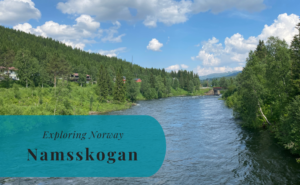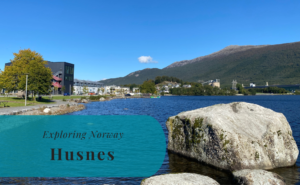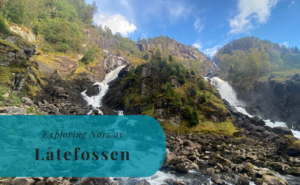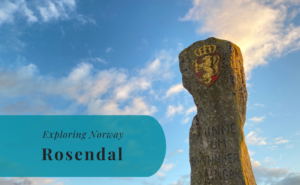Trondheim is with its around 186.000 inhabitants the largest city in Trøndelag County in central Norway. This also makes it the fourth-largest urban area in Norway, after Oslo, Bergen, and Stavanger. This city was for some centuries the capital of Viking Age Norway, with the important Trondheim Fjord as the main waterway for travelers. Today it is a modern technology-oriented town that is home to both the Norwegian University of Science and Technology and the Foundation for Scientific and Industrial Research.
Trondheim is also known by its Sámi name Tråante as well as the historical names of Kaupangen, Nidaros, and Trondhjem.





A Short History of Trondheim
Trondheim was founded already in the year 997 by the Norwegian king Olav Tryggvason. It was at the time known as Nidaros. even though Olav had named his new city Kaupang. The new-founded city was for centuries the Norwegian capital and the seat of Christianity. For several centuries, there were many different rulers, both Norwegian and foreign. The province of Trøndelag has been conquered by both Denmark and Sweden in the past, but the most recent defeat was to Nazi Germany during the Second World War.
Viking and the Middle Ages
Nidaros was the capital of Norway until the year 1217 when the capital was moved to Oslo. However, Nidaros remained the religious and spiritual center of Norway until the reformation in the 16th century. It was from what is today Trondheim that the Viking kings Olav Tryggvason and Olaf Haraldsson spread Christianity through Norway. Olaf Haraldsson would later also be known as Saint Olaf. It was under the rule of Saint Olaf in the early 11th century that Trondheim got its first bishop.
The bishop of Nidaros later received subordinate bishops in Oslo, Bergen, Stavanger, Hamar, Orkney, Skáholt (Iceland), Hólar (Iceland), and Garðar (Greenland), spreading the faith to many of the Viking possessions in the north. The last archbishop of Norway fled the country in 1537. It was also during the Middle Ages that the city started to get known by a new name, Trondheim. Well, at the time the name was actually Þróndheimr and later it turned into Trondhjem.
Until the Modern Day
Following the centuries after the Middle Ages, Trondheim continued to develop, but it also suffered from many devastating fires. The city and the province of Trøndelag were for most of the time a part of Denmark-Norway, where Norway was the lesser part of a personal union ruled by Copenhagen. This briefly changed in 1658 when the province came under Swedish rule for 10 months.
This was not the last time Trondheim came under Swedish rule. A new personal union replaced the old one when the union between Sweden and Norway was established in 1814. The union lasted almost a century until Norway’s independence in 1905. Later, in 1940, Nazi Germany occupied Norway. The occupation lasted until 1945. The time of nazi occupation is known especially for two things locally; the spies of the Gestapo, and the establishment of a submarine base.
Much of the traditional wooden buildings in the center of Trondheim date back to the first half of the 19th century. The many fires in the 1840s forced the city to demand that all new buildings were built with bricks. The surrounding urban areas continued with wooden buildings for many more decades. The second half of the 19th century meant the arrival of industrialization and the construction of both the railway and a new harbor.





Things to Do and See
The historical town of Trondheim has many sights, both specific buildings, but also whole neighborhoods. There is a lot of shopping and cultural life in the city center and there is the colorful neighborhood of Bakklandet that offers both small restaurants along the narrow streets framed by wooden buildings. This is just to mention a few of several popular districts and neighborhoods within the city.
Haltdalen Stavkirke
Haltdalen Stavkirke dates back to the 1170s and the village of Haltdalen, further inland within Trøndelag County. This wooden stave church was moved to Trondheim in the 1880s and was finally moved to Sverreborg Trøndelag Folkemuseum in 1937. The original intention was to restore the medieval feel of the church, meaning that additions made later on were removed and parts were replaced.
Kristiansten Fortress
High up on a hill overlooking the city is the Kristiansten Fortress. It was built in the 1680s with the main purpose to defend the city from any advances by Sweden. The fortress saw battle in 1718 during the Great Northern War when the Swedish forces were pushed back. The fortress was decommissioned by the army in 1816 and its canons were afterward repurposed as a warning system for the city.
Executions took place here during and following the occupation by Nazi Germany in the Second World War. At least 30 Norwegians were executed here in addition to several others from other countries. After the end of the war, this use continued for a few years. Collaborators and war criminals saw their end here then, including the Norwegian Gestapo agent Henry Rinnan and the German Gerhard Flesch, the leader of the Security Police in Norway during the occupation. The fortress has since been turned into a museum.
Nidarosdomen
Nidarosdomen, the Nidaros Cathedral, is in the center of Trondheim. Its construction began around the year 1070 on the burial site of King Olav Haraldsson, later Saint Olav. The cathedral was completed in the year 1300, about 230 years after construction began.
This is where new kings of Norway traditionally have been consecrated. It was until the reformation the seat of the Catholic Archdiocese of Nidaros. During the reformation in 1537, the cathedral became a part of the Church of Norway.
Nidelva
Nidelva is the river running through the city before reaching the Trondheim Fjord. It has its source at Lake Selbusjøen, about 30 kilometers upstream. In addition to offering great views of the city, the river is also famous for good fishing possibilities. Salmon is also according to some sources common closer to the mouth of the river.
Old Town Bridge
Gamle Bybro, the Old Town Bridge, is a pedestrian and bicycle bridge across the river Nidelva. It was built in 1681 and originally included a guarded iron gate. The bridge is today one of the city’s main landmarks.
Pirbadet
Pirbadet is the largest indoor waterpark in Norway. It includes several swimming pools, diving towers, and three waterslides, to mention a few of the attractions. Its location offers a view out over the Trondheim Fjord.
Rockheim
Rockheim is Norway’s national museum of pop and rock music. It opened in 2010 and has since been collecting and exhibiting Norwegian pop and rock music from the 1950s onward.
Rosenborg Ballklub & Lerkendal Stadion
Rosenborg Ballklub is the local soccer team and one of the most prominent of the Norwegian soccer teams when you look at the number of trophies. They were founded in 1917 and have since won the national first-tier league Elitserien 26 times and the Norwegian Football Cup 12 times. The team has played in UEFA Champions League on 11 occasions.
Rosenborg Ballklub plays their home games at Lerkendal Stadion. It has a capacity of 21.405 spectators and was inaugurated as early as 1947.
Skansen Fyr
Skansen Fyr is the lighthouse guiding boats to and from the Skansen basin and its boat harbor.
Sverresborg Trøndelag Folk Museum
Sverresborg is a part of Trondheim and is the location of the open-air museum Trøndelag Folk Museum. The museum includes more than 80 historical buildings from the region of Trøndelag. The oldest of these is the Haltdalen Stavkirke from the 1170s. This museum was founded in 1909 and the location of Sverresborg was chosen in 1914. Sverresborg was earlier the location of a fortress that was built in the 1180s and was in use until 1263. The castle hill is today all that is left of the former fortress.
Trondheim Fjord
Trondheimsfjorden, or Trondheim Fjord, is the large fjord right outside of the city, It is the third longest fjord in Norway, measuring 130 kilometers in length. It has been an important waterway since the Viking Age and is famous for the sightings of giant squids. A total of four giant squids have been found in the fjord, two of them found close to Ranheim in Trondheim in 1954.
Trondheim Maritime Museum & SDS Hansteen
Trondheim has a long maritime history and the Trondheim Maritime Museum exhibits a part of this long history. The museum covers the city’s trading traditions from the 17th century onwards.
The museum is also managing the steamship SDS Hansteen, dating back to 1866. This is the oldest surviving sailing steamship in Norway and has earlier been used as a research vessel and a royal yacht to mention a few.
Tyholttårnet
Tyholttårnet is the 128-meter-high TV and radio tower on the outskirts of Trondheim. It was completed in 1985 and includes a viewpoint at 75 meters and a rotating restaurant at 80 meters above the ground.





How to Get to Trondheim
- Flights: Trondheim Airport (TRD) is 32 kilometers to the east of the town. It offers both domestic and international flights.
- Car: Trondheim is along the E6 between Grong and Oppdal. This is also the ending point for roads E14 and E39. The E14 continues towards Östersund and Sundsvall in Sweden, E39 goes along the coast towards Molde.
- Train: There are many train routes available from Trondheim. These include towns like Bodø and Oslo, but also Storlien in Sweden.
The driving distance from 5 major Norwegian cities, according to Google Maps:
- Oslo – 491 kilometers (6 h 13 min)
- Bergen – 628 kilometers (9 h 40 min)
- Narvik – 897 kilometers (12 h 54 min)
- Kirkenes – 1517 kilometers (19 h 3 min)
Find out more about other destinations in Norway by visiting our page Exploring Norway






